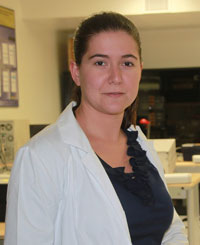| Sep 09, 2013 | |
New laser generation capable of generating chips within crystals |
|
| (Nanowerk News) The Basque cooperative research centre for microtechnologies, CIC microGUNE, is investigating new technology applications in the field known as femtosecond laser technology. This type of laser enables processing materials with a precision unthinkable with any other technique. Working inside transparent materials without damaging their surface, devising sensors that are more sensitive than current ones, or dealing with metals more precisely than with conventional lasers are some of its potential applications. | |
| The aim of CIC microGUNE is to generate knowledge in an environment which is set to expand considerably, given its application in industries the productive processes of which require great precision. Work involving femtosecond laser is, therefore, one example of the commitment by the Centre to boosting competitiveness in Basque industry through using microtechnologies. | |
| Femtosecond laser is used in surgery such as that involving myopia or cataracts, for the ability it has for passing through tissues without damaging them. However, it is not yet used in industry, given that its incidence is very different depending on the materials and the exact effects it has on them are not yet known with precision. | |
 Ainara Rodríguez It is precisely this – to determine with exactitude how it interacts under different conditions with different materials and, in consequence, to determine what possible applications this technology could have in industry – that CIC microGUNE is currently working on. “Today, this technology is employed only at research centres. The technology for its application in industry will be ready in two or three years” stated Ms. Ainara Rodríguez, lead researcher in femtosecond laser at CIC microGUNE. “Undoubtedly, its innumerable capacities will enable industry to obtain added value for its products”, she added. Possible applications One of its possible applications is the manufacture of structures embedded in transparent materials such as glass and plastic. Thanks to the possibility offered by this technology for working inside materials without damaging their surfaces, three-dimensional structures could be generated. This would enable the generation of chips or lenses embedded in a block of glass, for example; this having certain advantages, such as air-tightness and difficulty in falsifying them. Another of the most clearly exploitable uses is producing better sensors for chips. The capacity for detecting sensors is directly proportional to its sensor surface. Femtosecond laser is able to generate very precise microscopic-sized reliefs. These reliefs increase its sensor surface, thus conferring on it a greater capacity for detection. Thanks to this technique, more precise and smaller sensors can be generated. |
|
| This new generation laser could also be a technology of great interest in the metal industry and its derivatives; being able to make high-precision cuts while affecting surfaces less and to pull off material without heating it up, thus minimising the effect on it. This capacity would also be useful for polymeric materials such as plastics and resin. | |
| Femtosecond laser | |
| Femtosecond lasers emit a beam of light in such brief periods of time that they achieve very high power with great precision; the emission of pulses of this light energy lasts just a hundred femtoseconds (a femtosecond is a quadrillionth part of a second). | |
| “They say that, when laser was invented, it was a solution waiting for a problem to happen, given that, at the time, its use was unknown. Femtosecond laser is still more precise and its potential greater but, likewise, we only know that it could be applied in different ambits, some of which we are currently investigating”, explained Ms. Rodríguez. | |
| In fact, CIC microGUNE is already using this technology in various research projects under way, such as the Predetec project, financed by the Basque Government, and which aims to develop a device for detecting pathogens in food; the miDIAG project to develop rapid diagnosis microtechnology, also financed by the Basque Government. |
| Source: CIC microGUNE |
